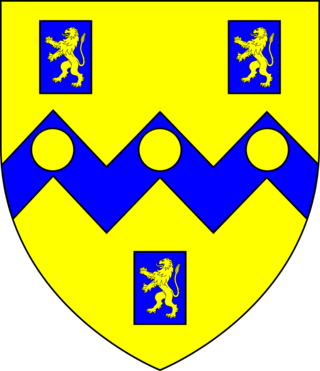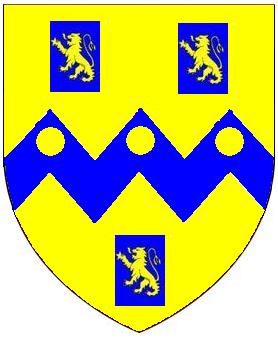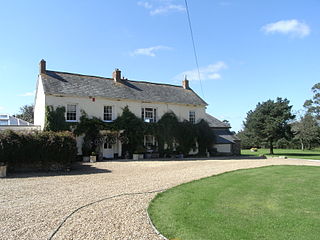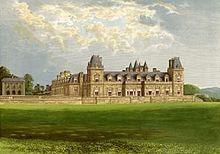
Beaford is a village and civil parish in the Torridge district of Devon, England. The village is about five miles south-east of Great Torrington, on the A3124 road towards Exeter. According to the 2001 census the parish had a population of 393, compared to 428 in 1901. The western boundary of the parish is formed by the River Torridge and it is surrounded, clockwise from the north, by the parishes of St Giles in the Wood, Roborough, Ashreigney, Dolton, Merton and Little Torrington.

Tristram Risdon was an English antiquarian and topographer, and the author of Survey of the County of Devon. He was able to devote most of his life to writing this work. After he completed it in about 1632 it circulated around interested people in several manuscript copies for almost 80 years before it was first published by Edmund Curll in a very inferior form. A full version was not published until 1811. Risdon also collected information about genealogy and heraldry in a note-book; this was edited and published in 1897.

Sir John Rolle, KB, of Stevenstone, Devon, was an English landowner, Sheriff of Devon in 1682 and MP for Barnstaple (1660) and for Devon (1661–1679). The Travel Journal of Cosimo III de' Medici, Grand Duke of Tuscany (1642-1723) states of him: "This gentleman is one of the richest in the country, having an estate of six thousand pounds sterling per annum, besides a considerable property in ready money".

Sir Hugh Pollard lord of the manor of King's Nympton in Devon, was Sheriff of Devon in 1535/6 and in 1545 was appointed Recorder of Barnstaple in Devon.

Huish is a small village, civil parish and former manor in the Torridge district of Devon, England. The eastern boundary of the parish is formed by the River Torridge and the western by the Rivers Mere and Little Mere, and it is surrounded, clockwise from the north, by the parishes of Merton, Dolton, Meeth and Petrockstowe. In 2001 the population of the parish was 49, down from 76 in 1901.

Hon. Mark George Kerr Rolle, of Stevenstone, St Giles in the Wood, Devon, was High Sheriff of Devon in 1864, a DL of Devon and High Steward of Barnstaple.

Stevenstone is a former manor within the parish of St Giles in the Wood, near Great Torrington, North Devon. It was the chief seat of the Rolle family, one of the most influential and wealthy of Devon families, from c. 1524 until 1907. The Rolle estates as disclosed by the Return of Owners of Land, 1873 comprised 55,592 acres producing an annual gross income of £47,170, and formed the largest estate in Devon, followed by the Duke of Bedford's estate centred on Tavistock comprising 22,607 with an annual gross value of nearly £46,000.

Sir Lewis Pollard of Grilstone in the parish of Bishop's Nympton, Devon, was Justice of the Common Pleas from 1514 to 1526 and served as MP for Totnes in 1491 and was a JP in Devon in 1492. He was knighted after 1509. He was one of several Devonshire men to be "innated with a genius to study law", as identified by Fuller, who became eminent lawyers at a national level. He was a kinsman of the judge and Speaker of the House of Commons Sir John Pollard.

Hall is a large estate within the parish and former manor of Bishop's Tawton, Devon. It was for several centuries the seat of a younger branch of the prominent and ancient North Devon family of Chichester of Raleigh, near Barnstaple. The mansion house is situated about 2 miles south-east of the village of Bishop's Tawton and 4 miles south-east of Barnstaple, and sits on a south facing slope of the valley of the River Taw, overlooking the river towards the village of Atherington. The house and about 2,500 acres of surrounding land continues today to be owned and occupied by descendants, via a female line, of the Chichester family. The present Grade II* listed neo-Jacobean house was built by Robert Chichester between 1844 and 1847 and replaced an earlier building. Near the house to the south at the crossroads of Herner the Chichester family erected in the 1880s a private chapel of ease which contains mediaeval woodwork saved from the demolished Old Guildhall in Barnstaple.

The Manor of Monkleigh was a mediaeval manor centred on the village of Monkleigh in North Devon, England, situated 2 1/2 miles north-west of Great Torrington and 3 1/2 miles south-east of Bideford.

John Rolle (1522–1570) of Stevenstone, in the parish of St Giles in the Wood, near Great Torrington, Devon, was the eldest son and heir of George Rolle, MP, founder of the great Rolle family of Stevenstone, by his second wife Eleanor Dacres. Three monuments survive in memory of his immediate family in the churches of St Giles in the Wood and Chittlehampton.

John Rolle (1679–1730) of Stevenstone and Bicton in Devon, was a British landowner and Tory politician who sat in the English House of Commons from 1703 to 1705 and in the British House of Commons from 1710 to 1730. He declined the offer of an earldom by Queen Anne, but 18 years after his death his eldest son was raised to the peerage in 1748 by King George II as Baron Rolle.

Hudscott is a historic estate within the parish and former manor of Chittlehampton, Devon. From 1700 it became a seat of a junior branch of the influential Rolle family of Heanton Satchville, Petrockstowe and in 1779 became a secondary seat of the senior Rolle family of Stevenstone, then the largest landowner in Devon. Hudscott House, classified in 1967 a Grade II* listed building, is situated one mile south-east of the village of Chittlehampton. It was largely rebuilt in the 17th century by the Lovering family and in the late 17th century became a refuge for ejected Presbyterial ministers. In 1737 its then occupant Samuel II Rolle (1703-1747) purchased the manor of Chittlehampton and thus Hudscott House became in effect the manor house of Chittlehampton.

Way is a historic estate in the parish of St Giles in the Wood, Devon. It is situated about 2 miles (3.2 km) north-east of the village of St Giles in the Wood and about 4 miles (6.4 km) north-east of the town of Great Torrington. It was described by Hoskins (1959) as "the fons et origo of the mighty tribe of Pollard" and had been acquired by them from the de la Way family at some time before 1242.

Bableigh is an historic estate in the parish of Parkham in North Devon, England. It is separated from the village of Parkham by the Bableigh Brook. It was the earliest recorded seat of the Risdon family in Devonshire, from which was descended the Devon historian Tristram Risdon.

Pill is an historic estate in the parish of Bishop's Tawton, near Barnstaple, in North Devon, England. The surviving 18th-century mansion house known as Pill House is a grade II* listed building situated close to the east bank of the River Taw about 1 mile south of the historic centre of Barnstaple and 1 mile north of Bishop's Tawton Church. It was long a seat of a junior branch of the Chichester family of Hall, Bishop's Tawton. At some time before 1951 it was converted into apartments and is at present in multiple occupation.

The large parish church of St Giles, which is in the village of St Giles in the Wood, Devon, England, came into being in 1309. When it was restored in 1862–3, many monuments were retained, including the monument and effigy of Thomas Chafe of Dodscott, three monumental brasses, of Alenora Pollard, Margaret Rolle of Stevenstone and a small brass of her husband John Rolle (d.1570). There are also 19th- and 20th-century monuments to the Rolle family.

Today, Winscott Barton is a large 19th-century farmhouse in the parish of St Giles in the Wood, Devon, England. It was built on the site of the mansion house belonging to Tristram Risdon, an early historian of Devon. The present building is Grade II listed.

The recorder of Barnstaple was a recorder, a form of senior judicial officer, usually an experienced barrister, within the jurisdiction of the Borough of Barnstaple in Devon. He was usually a member of the local North Devonshire gentry. The position of recorder of any borough carried a great deal of prestige and power of patronage. The recorder of a borough was often entrusted by the mayor and corporation to nominate its Members of Parliament, as was the case with Sir Hugh I Pollard, Recorder of Barnstaple, who in 1545 nominated the two MP's to represent the Borough of Barnstaple. In the 19th century a recorder was the sole judge who presided at a Quarter Sessions of a Borough, a "Court of Record", and was a barrister of at least five years' standing. He fixed the dates of the Quarter Sessions at his own discretion "as long as he holds it once every quarter of a year", or more often if he deemed fit.

Speccot is an historic estate in the parish of Merton in Devon, England. It was the seat of the de Speccot family, one of the oldest gentry families in Devon, which founded almshouses at Taddiport, near Great Torrington, Devon, in the 13th century. It is situated about one mile south-west of Potheridge, the seat of the Monck family from before 1287 to the late 17th century, who were thus close neighbours of the de Speccot family for many centuries. The present farmhouse known as "Speccot Barton" is Victorian and although no obvious traces of an earlier house survive, is marked "On Site of a Mansion" on the First Edition Ordnance Survey 25 inch map of 1880-99. The estate is today operated as a family-run sheep farm with six holiday cottages to let. A smaller house known as "Little Speccot" is situated on the approach lane to Speccot Barton.






















